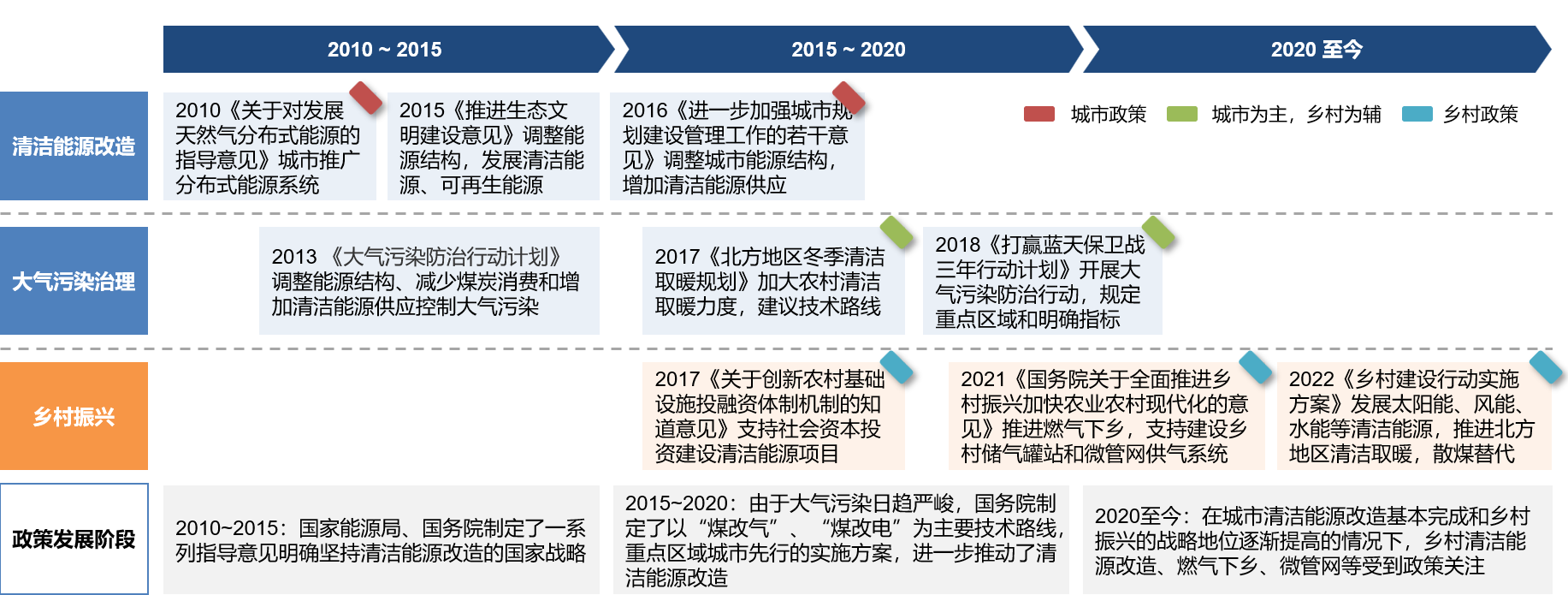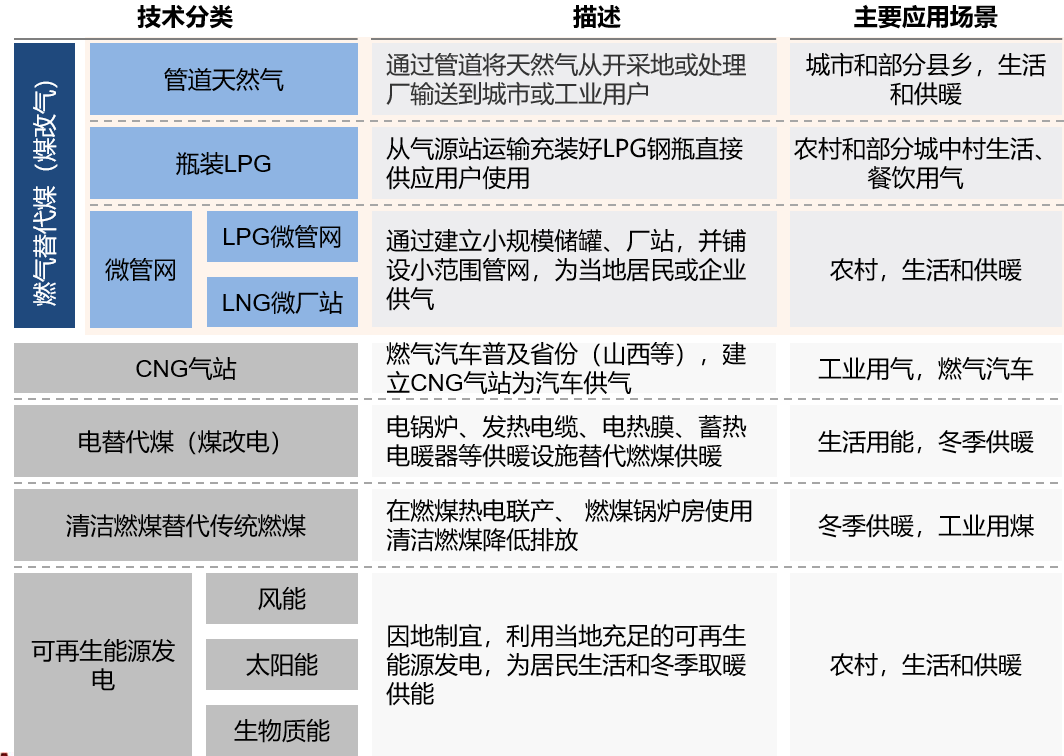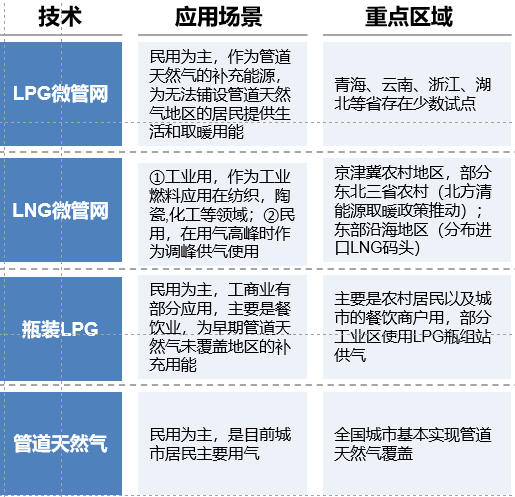

Homepage > Industrial news > Current situation and future development trend of clean energy transformation in China
Hits:2063 Createtime:2024-08-15 14:15:58
China has basically completed the transformation of clean energy in urban areas, and shifted the focus of energy transformation to rural areas
From 2010 to 2020, based on the background of air pollution prevention and control and energy structure adjustment, the government has issued a series of support policies for coal to gas and coal to electricity, and the relevant policy development timeline is shown as follows:

At present, the city has basically achieved clean energy coverage, with pipeline natural gas as the main energy source; The countryside is in its initial stage of development, and farmers are still accustomed to burning firewood or using bottled liquefied petroleum gas. With the basic completion of urban clean energy transformation, the strategic position of rural revitalization has gradually improved, and rural clean energy transformation has received policy attention as a rural infrastructure.
The energy needs of different regions promote a variety of clean energy transformation routes
The central government proposed the clean energy technology route of "coal to gas" and "coal to electricity", which is based on local conditions. Various transformation technologies have been formed in various places in the practice process, summarized as follows:

Among them, the technical routes of coal to gas include pipeline natural gas, bottled LPG, micro-pipe network gas supply, etc. Pipeline natural gas is the main gas used by urban residents, and the price of natural gas is controlled by the government. Pipeline natural gas is the main gas used by urban residents, and the price of natural gas is controlled by the government. LNG micro-plant station and LPG micro-pipe network technology are in the stage of technical exploration, and there are implementation and pilot in practice.
In northern China, under the promotion of the "winter clean energy heating" policy, most rural areas in the Beijing-Tianjin-Hebei region and some rural areas in the three northeastern provinces have installed LNG micro-plant station technology; At present, LPG micropipe network is mainly civilian, and pilot projects are carried out in Qinghai, Yunnan and other places under the promotion of China Gas. Both technologies have advantages and disadvantages, and gas companies are still experimenting and exploring them.
Overall, clean energy transformation in the northern and southern regions presents different characteristics, as follows:

There is demand for central heating in northern China, mainly through piped natural gas central heating in cities. In areas not covered by central heating, small coal-fired boilers, natural gas, electricity, renewable energy and other distributed heating are used as supplements. In urban and rural areas, most of the heating is distributed, and a large number of wood-fired stoves, kang, stoves or earth heating are used for heating.
The South is rich in water resources, mainly hydropower, solar photovoltaic power generation and other new energy power generation technologies. Cities are basically covered with natural gas pipelines, and rural households generally cook and boil water on firewood.
In the long run, clean energy transformation is still a long-term policy of China's development, the future energy transformation center will shift from "urban" to "rural", the transformation route focus from coal to gas to coal to electricity, coal to gas will change from "priority development of natural gas" to a variety of gas supply modes coexist.
Future development trend of rural clean energy transformation
The development time of China's clean energy transformation is later than that of developed countries, and there are still many problems to be solved in the implementation process:
First of all, China's clean energy industry development time is short, lack of experience, weak industrial foundation, compared with developed countries, product quality and industrial competitiveness still need to be improved; Secondly, the financial and tax policy guarantee system is not perfect, mainly reflected in the lack of diversity of relevant policies, non-uniform industry standards, limitations in the scope of policies and so on, and did not give full play to the supporting role of policies.
Overall, the clean energy transformation is most affected by the policy, and the large-scale application of pipeline natural gas benefits from the continuity of the policy and actual subsidies. Other transformation methods lack central economic subsidies, the promotion basically relies on the resources of enterprises themselves and local governments, and the coverage of technological transformation is limited.
At present, the civil market is basically dominated by Chinese gas, mainly pilot projects, low return on investment, long cycle; The root gas consumption of the industrial market is larger than that of civil projects. For pipeline gas, the purchase price of the gas source for civil users is favorable, and if the gas consumption is large, there is the possibility of profit.
To sum up, in order to further promote rural coal to gas, coal to electricity, different roles need to play a role:
The government needs to issue feasible fiscal policies, and the policies need to be continuous, which can stimulate the enthusiasm of users to replace and reduce the cost of enterprises' initial investment.
As the promoters of clean energy transformation technology, gas enterprises should strengthen the publicity and promotion of users, take the industrial market as a breakthrough, and actively expand the civil market;
As the supplier of gas enterprises, gas supply equipment manufacturers should actively cooperate with gas enterprises to design gas supply schemes and develop and produce equipment more suitable for rural scenes.
Online consultation
>Hotline
400-966-0397




